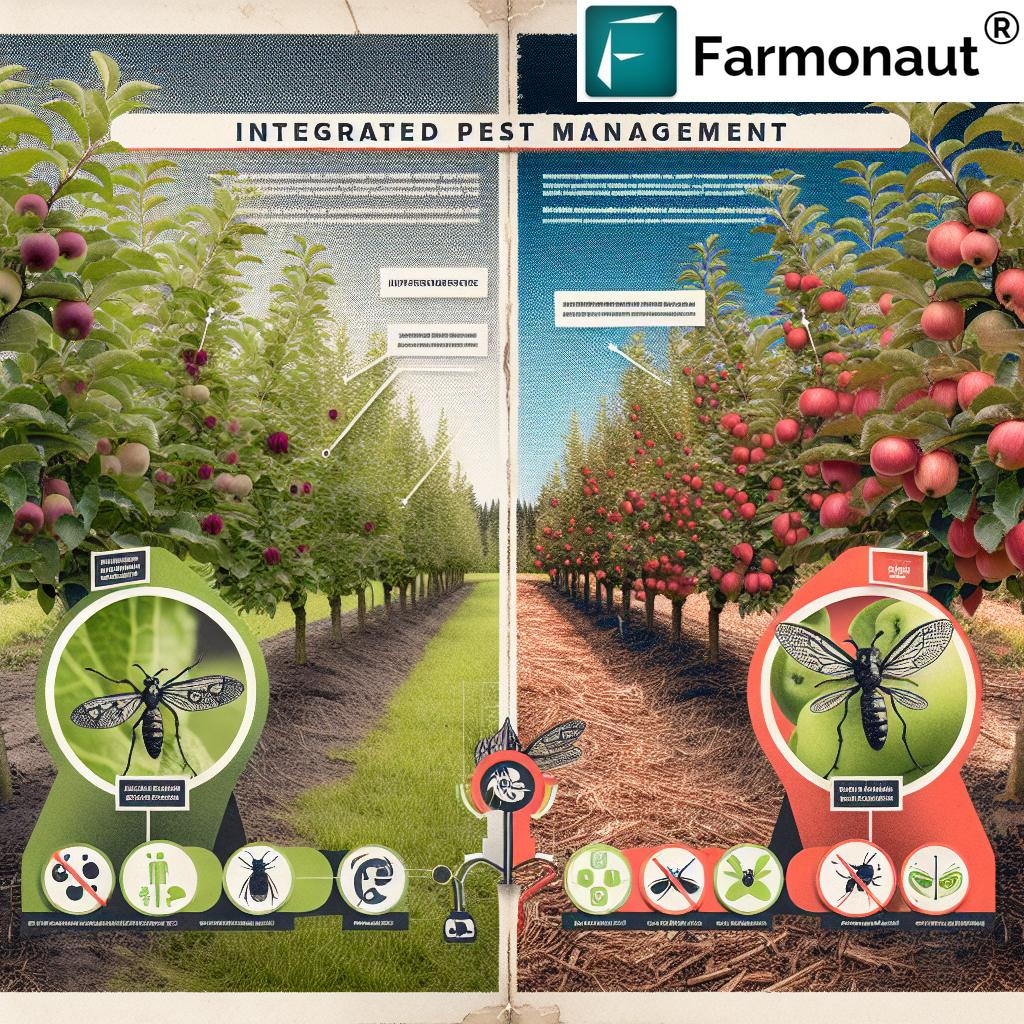Sustainable Dairy Farming in Canada: How Farmers Are Innovating for a Net-Zero Future

“Canadian dairy farmers aim to achieve net-zero emissions by 2050, revolutionizing milk production practices.”
Welcome to our comprehensive exploration of sustainable dairy farming in Canada. As we delve into the innovative practices and cutting-edge technologies reshaping the industry, we’ll uncover how Canadian farmers are paving the way for a greener, more sustainable future. From soil health preservation to advanced waste management solutions, we’ll examine the multifaceted approach that’s propelling Canadian milk production towards net-zero emissions by 2050.
The Evolution of Canadian Dairy Farming
Canadian dairy farming has come a long way since its humble beginnings. Today, it stands at the forefront of agricultural innovation, embracing sustainable practices that benefit both the environment and consumers. As we navigate through this blog post, we’ll explore how the industry is evolving to meet environmental challenges while maintaining high standards of food safety and animal welfare.
- Embracing regenerative agriculture practices
- Implementing cutting-edge technologies for farm management
- Focusing on animal welfare and nutrition
- Adapting to climate change and reducing carbon footprint
Let’s dive deeper into the world of sustainable dairy farming in Canada and discover how farmers are innovating for a net-zero future.
Soil Health Preservation: The Foundation of Sustainable Dairy Farming
At the heart of sustainable dairy farming lies the crucial practice of soil health preservation. Canadian dairy farmers recognize that healthy soils are the foundation of a thriving agricultural ecosystem. By implementing innovative techniques, they’re not only improving crop yields but also enhancing the environment’s overall health.
Key Soil Health Practices:
- Cover Cropping: Planting cover crops between regular crop rotations helps prevent soil erosion, improve soil structure, and increase organic matter content.
- Minimal Tillage: Reducing soil disturbance helps maintain soil structure and promotes beneficial microbial activity.
- Crop Rotation: Rotating crops helps break pest cycles, improves nutrient cycling, and enhances soil biodiversity.
- Composting: Utilizing farm-generated compost enriches soil with organic matter and beneficial microorganisms.
These practices not only contribute to better soil health but also play a significant role in carbon sequestration, helping offset greenhouse gas emissions from dairy operations.
Water Conservation Methods in Canadian Dairy Farms
Water is a precious resource, and Canadian dairy farmers are at the forefront of implementing innovative water conservation methods. By adopting efficient irrigation systems and water management practices, they’re reducing water usage while maintaining optimal crop and livestock health.
Innovative Water Conservation Techniques:
- Precision Irrigation: Using advanced sensors and weather data to apply water only when and where it’s needed.
- Rainwater Harvesting: Collecting and storing rainwater for use during dry periods.
- Wastewater Recycling: Treating and reusing wastewater for irrigation and cleaning purposes.
- Drought-Resistant Crops: Planting varieties that require less water without compromising nutritional value for livestock.
These water conservation efforts not only reduce the environmental impact of dairy farming but also contribute to the long-term sustainability of the industry.
Cutting-Edge Waste Management Solutions
Effective waste management is crucial for sustainable dairy farming. Canadian farmers are implementing innovative solutions to turn what was once considered waste into valuable resources, reducing environmental impact and creating new revenue streams.
Advanced Waste Management Practices:
- Anaerobic Digestion: Converting manure and organic waste into biogas for energy production.
- Composting Systems: Transforming organic waste into nutrient-rich fertilizer for crops.
- Precision Manure Application: Using GPS-guided systems to apply manure efficiently, reducing runoff and optimizing nutrient use.
- Phosphorus Recovery: Extracting phosphorus from waste streams for use as a valuable fertilizer.
These waste management solutions not only reduce the environmental footprint of dairy farms but also contribute to a circular economy within the agricultural sector.
The proAction® Initiative: Ensuring Quality and Sustainability
The proAction® initiative is a comprehensive program that ensures quality, sustainability, and best practices across the Canadian dairy industry. This national framework sets high standards for milk production, animal welfare, food safety, and environmental stewardship.
Key Components of proAction®:
- Milk Quality: Rigorous testing and monitoring to ensure the highest quality of milk production.
- Food Safety: Implementing strict protocols to guarantee safe milk from farm to table.
- Animal Care: Ensuring the well-being of dairy cows through best practices in animal husbandry.
- Livestock Traceability: Maintaining detailed records for animal tracking and disease prevention.
- Biosecurity: Implementing measures to prevent the introduction and spread of disease.
- Environment: Promoting sustainable farming practices and environmental stewardship.
Through proAction®, Canadian dairy farmers demonstrate their commitment to producing high-quality, sustainable milk while adhering to stringent industry standards.
“The proAction® initiative ensures quality and sustainability across Canada’s dairy industry, impacting thousands of farms nationwide.”
Genetic Improvements and Herd Management
Advancements in genetics and herd management are playing a crucial role in enhancing the sustainability of Canadian dairy farms. By focusing on breeding more efficient and resilient cows, farmers are improving productivity while reducing the environmental impact of their operations.
Key Areas of Genetic and Herd Management Innovation:
- Genomic Selection: Using DNA analysis to identify and breed cows with desirable traits such as higher milk production and disease resistance.
- Feed Efficiency: Breeding cows that can produce more milk with less feed, reducing overall resource consumption.
- Longevity: Focusing on traits that increase the productive lifespan of cows, reducing replacement rates and overall herd size.
- Methane Reduction: Researching genetic factors that contribute to lower methane emissions in dairy cows.
These advancements in genetics and herd management are essential components of the industry’s journey towards net-zero emissions, contributing to both farm productivity and environmental stewardship.
Explore Farmonaut’s API for advanced agricultural insights
Nutritional Benefits of Canadian Dairy Products
While focusing on sustainability, it’s crucial to highlight the nutritional benefits that make dairy an essential part of a healthy diet. Canadian dairy products are known for their high quality and nutritional value, contributing significantly to public health.
Key Nutritional Benefits:
- Calcium: Essential for bone health and muscle function.
- Protein: High-quality complete protein for muscle growth and repair.
- Vitamin D: Crucial for calcium absorption and immune function.
- Vitamin B12: Important for nerve function and red blood cell formation.
- Potassium: Helps maintain healthy blood pressure levels.
By producing nutritious dairy products through sustainable practices, Canadian farmers are contributing to both environmental and public health goals.
The Role of Dairy Farming in Canada’s Economy and Food Security
Dairy farming plays a vital role in Canada’s economy and food security. The industry not only provides high-quality, nutritious products but also supports rural communities and contributes significantly to the national GDP.
Economic and Food Security Impacts:
- Job Creation: The dairy industry provides employment for thousands of Canadians, both directly on farms and in related sectors.
- Rural Development: Dairy farms are often the backbone of rural communities, supporting local businesses and services.
- Food Security: Domestic dairy production ensures a stable supply of essential nutrients for Canadians.
- Export Opportunities: High-quality Canadian dairy products are sought after in international markets.
As the industry moves towards greater sustainability, it continues to strengthen its role in Canada’s economic and food security landscape.
Access Farmonaut’s API Developer Docs for integration guides
Farmonaut’s Technology: Supporting Sustainable Dairy Farming
In the pursuit of sustainable dairy farming, technology plays a crucial role. Farmonaut, a leading agricultural technology company, offers innovative solutions that support Canadian dairy farmers in their sustainability efforts.
How Farmonaut Supports Sustainable Dairy Farming:
- Satellite-Based Crop Health Monitoring: Helps farmers optimize feed production for dairy cows.
- AI-Driven Advisory System: Provides personalized recommendations for efficient farm management.
- Resource Management Tools: Assists in optimizing water and fertilizer use on dairy farms.
- Carbon Footprint Tracking: Helps farmers monitor and reduce their environmental impact.
By leveraging Farmonaut’s technology, Canadian dairy farmers can make data-driven decisions that improve crop management, resource efficiency, and overall farm sustainability.

Sustainable Dairy Farming Practices in Canada
| Practice | Environmental Benefit | Implementation Rate (%) |
|---|---|---|
| Soil Health Preservation | Improves carbon sequestration, reduces erosion | 85% |
| Water Conservation | Reduces water usage, protects local water sources | 78% |
| Waste Management | Reduces pollution, creates renewable energy | 70% |
| Genetic Improvements | Increases efficiency, reduces methane emissions | 92% |
| Herd Management | Optimizes resource use, improves animal welfare | 88% |
This table provides a clear overview of the key sustainable practices adopted by Canadian dairy farmers, their environmental benefits, and the impressive implementation rates across the industry.
The Path to Net-Zero Emissions in Canadian Dairy Farming
The Canadian dairy industry has set an ambitious goal of achieving net-zero emissions by 2050. This target requires a comprehensive approach that encompasses all aspects of dairy farming, from feed production to waste management.
Key Strategies for Achieving Net-Zero:
- Energy Efficiency: Implementing energy-saving technologies and practices across farm operations.
- Renewable Energy Adoption: Increasing the use of solar, wind, and biogas energy on dairy farms.
- Carbon Sequestration: Enhancing soil health practices to increase carbon storage in farmland.
- Methane Reduction: Implementing feed additives and manure management practices to reduce methane emissions.
- Precision Agriculture: Utilizing data-driven approaches to optimize resource use and reduce waste.
The journey to net-zero emissions is challenging but achievable, with Canadian dairy farmers leading the way in innovative and sustainable practices.
The Future of Sustainable Dairy Farming in Canada
As we look to the future, the Canadian dairy industry is poised to continue its leadership in sustainable farming practices. Ongoing research and development in areas such as precision agriculture, biotechnology, and circular economy principles will drive further innovations in the sector.
Emerging Trends and Technologies:
- AI and Machine Learning: Advanced algorithms for optimizing farm operations and predicting environmental impacts.
- Vertical Farming: Exploring vertical farming techniques for feed production to reduce land use.
- Blockchain Technology: Enhancing traceability and transparency in the dairy supply chain.
- Bioplastics from Dairy Waste: Developing biodegradable plastics from dairy by-products.
These advancements will not only contribute to environmental sustainability but also enhance the economic viability of Canadian dairy farms.
Conclusion: A Sustainable Future for Canadian Dairy
As we’ve explored throughout this blog post, sustainable dairy farming in Canada is not just a goal but a rapidly evolving reality. From soil health preservation to cutting-edge waste management solutions, Canadian dairy farmers are at the forefront of agricultural innovation, paving the way for a net-zero future.
The industry’s commitment to sustainability, as exemplified by initiatives like proAction® and the adoption of advanced technologies, ensures that Canadian dairy products will continue to be produced with the highest standards of quality, safety, and environmental stewardship. As consumers, we can take pride in supporting a dairy industry that not only provides nutritious products but also prioritizes the health of our planet.
The journey towards net-zero emissions by 2050 is ambitious, but with the dedication of Canadian dairy farmers and the support of innovative technologies like those offered by Farmonaut, it’s a goal well within reach. As we look to the future, we can be confident that Canadian dairy farming will continue to evolve, innovate, and lead the way in sustainable agriculture practices.
FAQ: Sustainable Dairy Farming in Canada
- Q: What is net-zero emissions in dairy farming?
A: Net-zero emissions mean that the greenhouse gases produced by dairy farming operations are balanced by an equivalent amount of gases removed from the atmosphere through various practices and technologies. - Q: How are Canadian dairy farmers reducing their carbon footprint?
A: Canadian dairy farmers are reducing their carbon footprint through practices such as improving soil health, implementing efficient waste management systems, adopting renewable energy sources, and using precision agriculture techniques. - Q: What is the proAction® initiative?
A: proAction® is a national quality assurance program that sets high standards for milk quality, food safety, animal care, traceability, biosecurity, and environmental stewardship in Canadian dairy farms. - Q: How does sustainable dairy farming benefit consumers?
A: Sustainable dairy farming ensures the production of high-quality, nutritious dairy products while minimizing environmental impact, preserving natural resources, and supporting local economies. - Q: What role does technology play in sustainable dairy farming?
A: Technology, such as Farmonaut’s satellite-based monitoring and AI advisory systems, helps farmers make data-driven decisions to optimize resource use, improve crop and animal health, and reduce environmental impact.
















